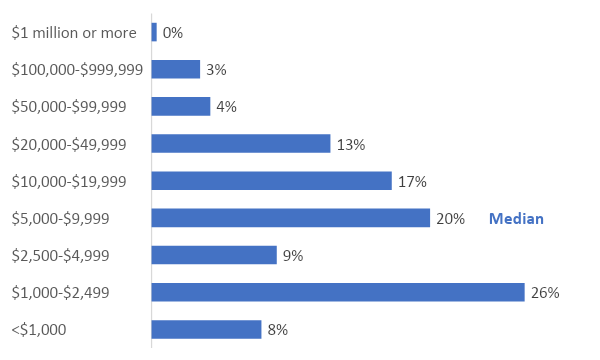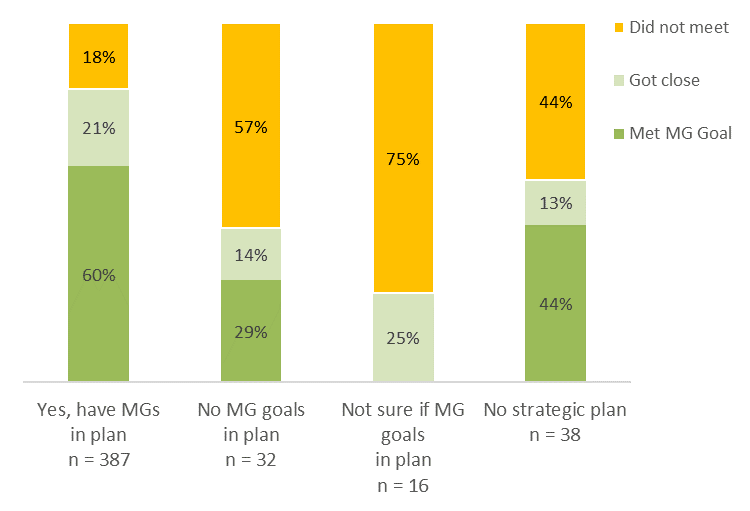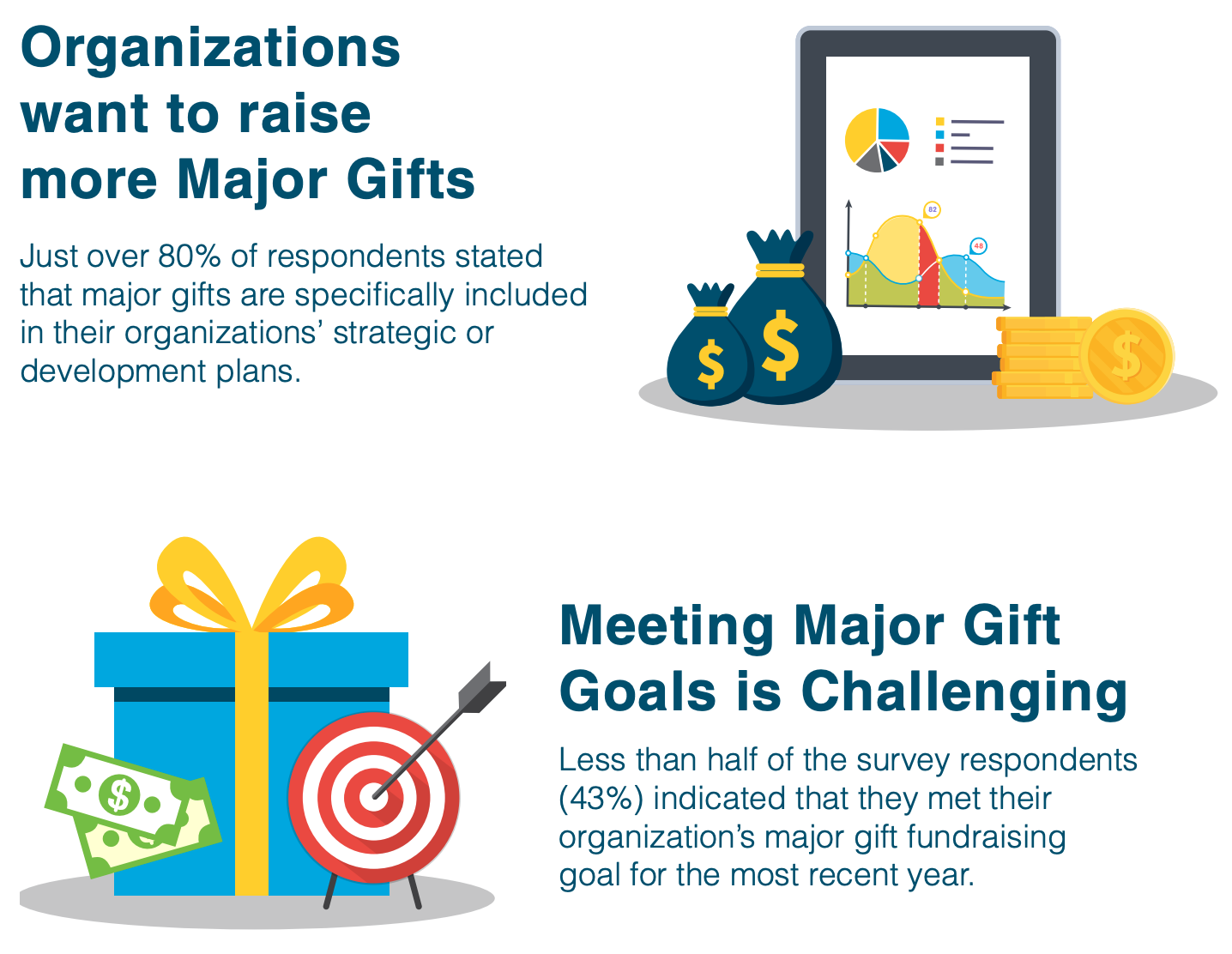We use cookies to ensure that we give you the best experience on our website. By continuing to use this site, you agree to our use of cookies in accordance with our Privacy Policy.
 Login
Login
Your Role
Challenges You Face
results
Learn
Resources
Company
Only 43 Percent of Organizations Met Their Major Gift Fundraising Goals in 2019


You don’t have to be Sherlock Holmes to know that major gift fundraising is of the utmost importance. Whether it be reports from Giving USA, the Association of Fundraising Professionals Fundraising Effectiveness Project, or Fundraising Report Card’s Live Benchmarks, all signs point towards fewer donors giving more dollars.
The math isn’t tricky. Less donors and more dollars equates to larger average donation amounts, and a growing reliance on major donors to help charities attain their fundraising goals. Couple this with the growth of donor-advised funds, and you have a “perfect storm” in the making.
More and more charities are finding themselves relying on large dollar donors to help them attain their fundraising goals. A shift from investing in events, galas, walks, and the sort is among us. We’re seeing more and more organizations reappropriate funds into major and legacy gift fundraising efforts.
This is nothing new. As a sector we’ve been able to see these trends. Giving USA’s annual report has highlighted this. National Philanthropic Trust’s report on DAFs has done the same. What is new then?
As of today, we now have updated research on the state of major gift fundraising. I’m pleased to announce that the 2020 Major Gift Benchmark Study Report is almost complete and ready for distribution.
Let’s dive into three key findings from the research, which was conducted by Melissa Brown, of Melissa S. Brown & Associates.
No change in “what is a major gift” from 2016
The Major Gift Benchmark Study was first conducted in 2016. If you’re interested, click here to view the first report. It is compelling, and worthwhile to compare results from then and now. Although respondents to both surveys are not identical, we can still compare what we learned then with what we know now.
One of the more interesting findings was that the size of a major gift is still defined the same as it was back in 2016.
It’s seemingly a question as old as time itself, “What constitutes a major gift?” Participants in the Major Gift Benchmark Study selected a range that included the minimum value that qualifies as a major gift at their organization. Someone who selected the range of $1,000 to $2,499 might work at an organization where $1,000, $1,500, or $2,000 is the minimum amount for a “major gift.”
The most frequent response (the mode) is in the range of $1,000 to $2,999. 26 percent of respondents selected this option. However the midpoint (the median) is $5,000 to $9,999. This means that half of respondents selected this option or less, and half selected this option or more.

These are the same values we found in 2016 in the first Major Gift Benchmark Study: a mode (most frequent) of $1,000 to $2,499 and a median in the $5,000 to $9,999 range.
With a 10 percent increase in national personal income between 2016 and 2019, and the introduction of “mid-level giving programs” in many organizations, it would be rational to think that the size of what constitutes a major gift would have evolved. However, in this study we were not able to identify any shift.
Building a pipeline of qualified prospects is hard
If raising major gifts was easy, every organization would be doing it. Building relationships with key constituents takes time, energy, and a bit of luck. Another key finding from the Major Gift Benchmark Study was with regards to fundraisers satisfaction with their pipeline of prospects.
The finding? Just 34 percent of participants reported being satisfied with their organization’s pipeline of major gift prospects. A larger share (48 percent) were dissatisfied, and 17 percent were neutral.
43 percent of organizations met their major gift fundraising goals
Last but not least, we’d be remiss to not acknowledge one of the most striking results from the Major Gift Benchmark Study. Just 43 percent of respondents reported that they met their major gift fundraising goal in 2019.
15 percent said they got close to meeting their goal, and 25 percent of respondents said their organization does not have dollar goals for major gifts.

We found that organizations with no strategic plan, or with no major gift goals in their plan, were far less likely to meet their major gift fundraising goals. In the full report we explore what other factors impact your organizations likelihood to attain major gift fundraising success. Receive early access to the full report by clicking here.

This finding (that having a plan equates to better outcomes) is further validation to a 2015 study entitled the Individual Donor Benchmark Report. We find, in general, that organizations that invest in major gift fundraising and include that investment as part of a strategic plan, regardless of organizational size, are more likely to meet their major gift fundraising goals.
So what does all this data mean? You can (and should!) interpret it in different ways. At MarketSmart, the reason we fund research like the Major Gift Benchmark Study is to further the conversation in our sector about major and legacy giving strategies that are most effective. Data is meant to take emotion out of the equation. We know that philanthropy is evolving, and through research like this, we aspire to see how we can keep up.
Get smarter with the SmartIdeas blog
Subscribe to our blog today and get actionable fundraising ideas delivered straight to your inbox!

